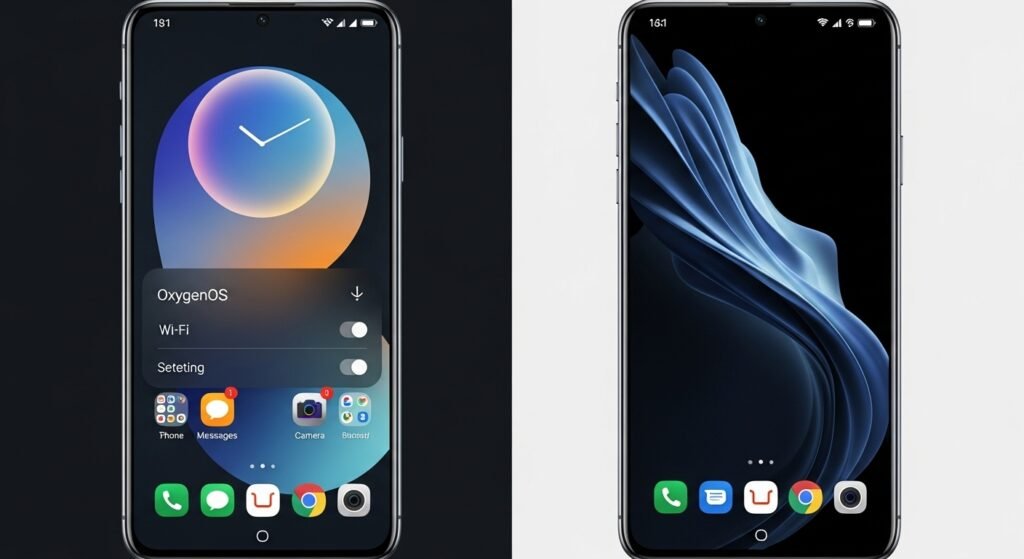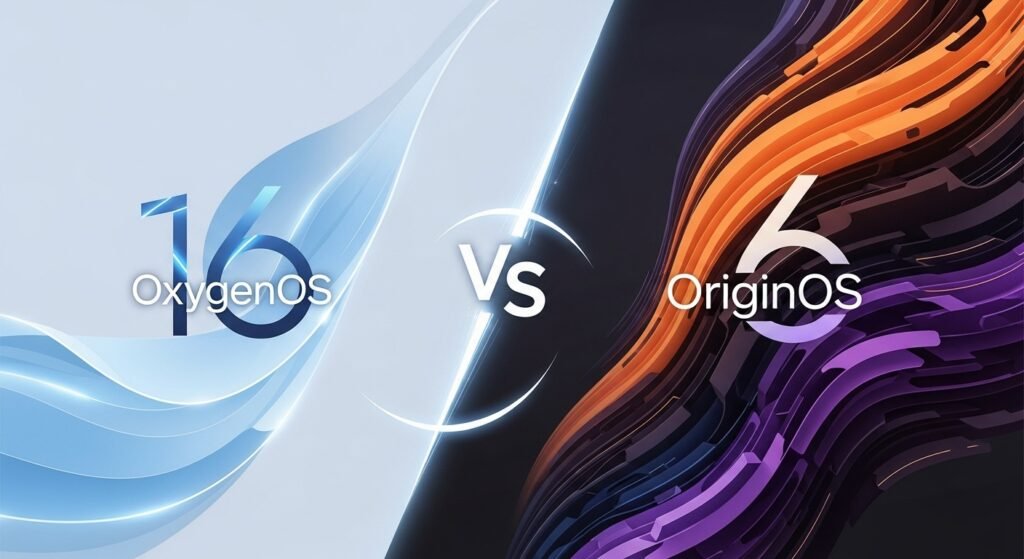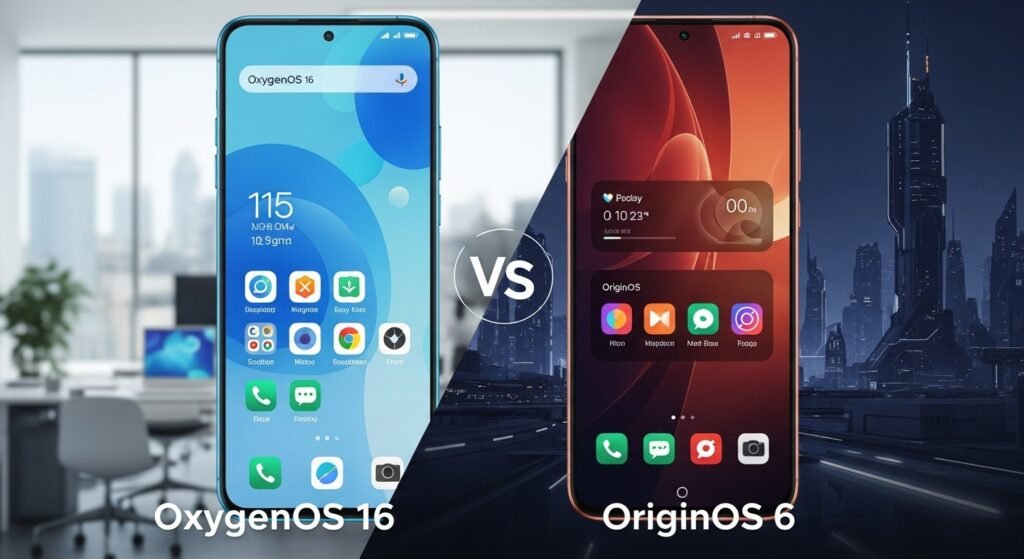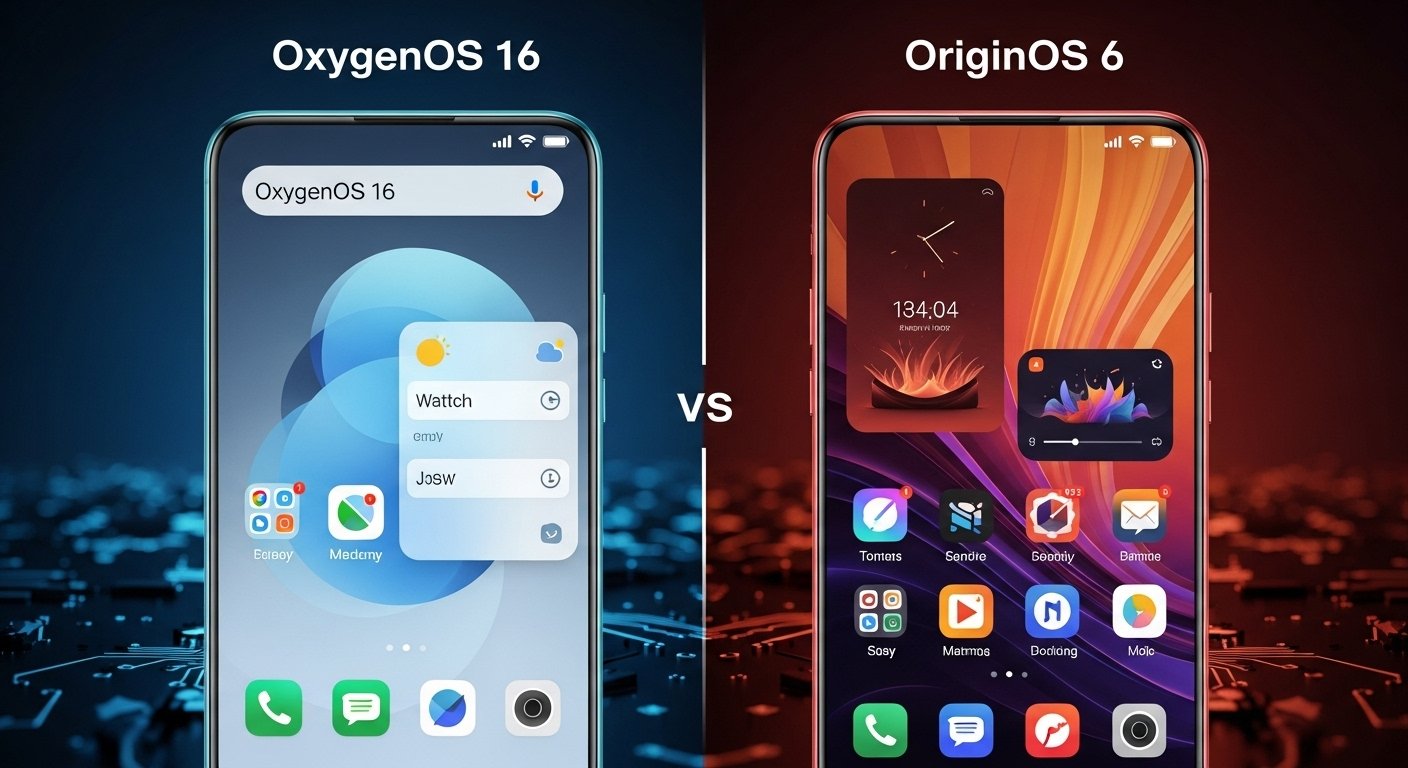OxygenOS 16 vs OriginOS 6 : A head-to-head comparison of animations, customization, AI features, privacy tools and more — plus a final score to settle the debate.
Smartphone UIs are more than just visual candy — they shape daily interactions, speed of use, and how easily you get things done. OxygenOS 16 (OnePlus) and OriginOS 6 (Vivo) are two of the most-talked-about skins this year. I spent time using both side-by-side so you don’t have to. Below is a feature-by-feature comparison, followed by a final score.
Summary Score (at a glance)
- OxygenOS 16: 7.5 points
- OriginOS 6: 4.5 points
Scroll down for how those points were earned.
1. Animations — Smoothness vs Snappiness
What I checked: app open/close, notification and quick settings transitions, recent apps, AOD → lock → home transitions.
- OxygenOS 16: Pristine, polished animations. Transitions feel fluid and lifelike, especially when moving between AOD, lock screen and home.
- OriginOS 6: Slightly snappier — actions feel faster even if they aren’t quite as silky.
Verdict: OxygenOS wins this round for overall smoothness. (OxygenOS: 1 / OriginOS: 0.5)
2. Lock Screen & Always-On Display
What I checked: lock screen customization, dynamic wallpapers, AOD support, lock shortcuts and widgets.
- OriginOS 6: Lets you set multiple lock-screen photos and changes them with tilt animations — a distinctive and eye-catching effect. Custom transition controls are slick and immediate.
- OxygenOS 16: Offers live photos with depth effects and lets almost any wallpaper be used as AOD. More limited immediate customizability, but the unlock animation and overall polish are excellent.
Verdict: Tied on features and aesthetic; both have advantages. (OxygenOS: 1 / OriginOS: 1)

3. Home Screen & Customization
What I checked: icon and folder scaling, shortcuts, widget layout, icon packs, app drawer search placement.
- OxygenOS 16: You can scale individual app icons and add up to three shortcuts per icon — incredibly useful for power users and accessibility. Clean widget page (alphabetical, no clutter) and bottom-placed app drawer search for reachability. Also supports custom icon packs from the customization page.
- OriginOS 6: Folder scaling is supported, but not per-app icon scaling. Icon pack support requires third-party launchers. Widgets are visually interesting but the UX is less straightforward.
Verdict: OxygenOS takes this one for usability and system-level customization. (OxygenOS: 1 / OriginOS: 0)
4. Lock PIN, Notifications & Quick Settings (iOS Influence)
What I checked: PIN layout aesthetics, stacked notifications, quick settings customization, Dynamic Island-style features.
- OxygenOS 16: Polished PIN UI with nice shadows, stacked notifications handled well, and a superior interpretation of Dynamic Island — it surfaces multiple active activities and groups live alerts more usefully than iOS or OriginOS. Quick settings are highly customizable.
- OriginOS 6: Excellent stacked notifications (even inside the notification panel) and a solid quick settings layout, but less flexibility in top-section customization.
Verdict: OxygenOS for best blend of form and function. (OxygenOS: 1 / OriginOS: 0.5)

5. Unique Interaction Features
What I checked: drag-and-drop sharing, global search, haptic customization, AI integration.
- OriginOS 6: The super-dragging gesture (drag media to a share target) is wonderfully quick and intuitive for sharing files, links and text. Haptics offer more sliders and granular control.
- OxygenOS 16: Global search is more powerful — it looks through system settings, saved documents and files (very handy). Haptics integration is tighter (e.g., feedback on brightness/volume). OxygenOS’s AI features (including deeper Gemini-like integration and an AI writer in social apps) are ahead in maturity and usefulness.
Verdict: OxygenOS for AI and search; OriginOS for novel interaction. (OxygenOS: 1 / OriginOS: 0.5)
6. Security & Privacy
What I checked: private space capabilities, password typing protections, system-level privacy tools.
- OxygenOS 16: Uses a secure keyboard switch when typing passwords (auto-switches from Gboard to OnePlus secure keyboard) — a great extra layer against key-logging.
- OriginOS 6: Offers a true full-device Private Space — essentially a parallel, fully independent environment where you can install apps, use the camera and operate as if it were a separate phone. This is more flexible than simple hidden folders or vaults.
Verdict: Slight edge to OriginOS for the depth of private-space functionality. (OxygenOS: 0.5 / OriginOS: 1)
7. Ecosystem & Connectivity
What I checked: cross-device kits, phone-to-PC/IoT integrations and overall ecosystem polish.
- OxygenOS 16: Includes O-Plus Connect and promises broader device compatibility. Apple Watch support is claimed but inconsistent at the moment.
- OriginOS 6: VO Office Kit and strong local device integration. Both ecosystems work well but neither clearly dominates at present.
Verdict: Tie for practical ecosystem functionality. (OxygenOS: 1 / OriginOS: 1)

8. Bloatware & Search Ads
What I checked: preinstalled apps, home/search recommendations and ads.
- OriginOS 6: Has more curated recommendations and some ads or promoted content in global search — not ideal on a flagship-priced device.
- OxygenOS 16: Cleaner out of the box with fewer intrusive recommendations.
Verdict: Point to OxygenOS for a cleaner user experience. (OxygenOS: 1 / OriginOS: 0)
Final Tally & Takeaway
- OxygenOS 16: 7.5 points
- OriginOS 6: 4.5 points
The verdict: OxygenOS 16 leads by a clear margin — it pairs refined animations and thoughtful polish with stronger system-level customization, better global search, mature AI tools, and a cleaner default experience. OriginOS 6 is an ambitious and creative skin with excellent interaction ideas (super-dragging, multi-photo lockscreen) and a very capable private-space mode — but it still trails OxygenOS in overall cohesion and mature AI & feature integration.
That said: OriginOS is making impressive strides and is far improved from its earlier iterations. If Vivo continues to refine customization, reduce promotional content and expand system-level features, the gap could narrow significantly.
Which should you choose?
- Choose OxygenOS 16 if you value smooth polish, top-tier customization, powerful search and mature AI features.
- Choose OriginOS 6 if you prioritize innovative sharing gestures, bold lock-screen visuals, and a robust private-space implementation.
